Abstract
Agriculture encroachment over alpine pastoral land is posing serious threats to the sustainable use of natural resources and agro-pastoral systems in the upland environment. This study aimed to understand the scenario of agriculture encroachment within a sustainable land management context in Northern Pakistan’s uplands (Buhrawai). Both quantitative and qualitative methodological approaches were used for the primary data collection on the pattern of cropland expansion, cropland productivity, agrochemical inputs, and perceived socio-ecological system. The results showed that off-season agriculture has emerged as a cash-earning livelihood activity, largely adopted by decade-old and influential tenant communities in the study areas. During the last few decades, this off-season agriculture regularly expanded from lower- to higher-elevation (2980–3800 m) areas, and extensively encroached on accessible pastoral areas in the bottomlands. Cultivation of the two major vegetable crops, i.e., peas and potatoes, occurred on a total of 417.4 ha of pastoral land, where pea cultivation predominantly occurred on 367.2 ha and potato cultivation on 50.2 ha of pastoral land. We found that repeated cultivation of the same crops, without crop rotation and land management practices, significantly reduced land productivity with time; the crop productivity was recorded to be the highest in the virgin cultivated land (pea: 1.8 tons/ha and potato: 14.8 tons/ha) and the lowest in the old-cultivated land (pea: 0.6 tons/ha and potato: 8.2 tons/ha). As a result of this trend, farmers are abandoning unproductive agricultural land and subsequently starting cultivation in other marginal areas, even cultivating crops on steeper slopes beyond the permissible level (16°). These findings revealed that farmers have extensively used key pastoral areas for cultivation, and they have deprived landless pastoralists of their traditional grazing land in the uplands. Furthermore, this agriculture encroachment imposed serious pressure on the pastoralists’ livelihoods and the upland ecosystem on which they rely. Therefore, policies and regulations that promote sustainable land management are much needed to ensure socio-economic equity and ecological integrity in the uplands of Northern Pakistan.
1. Introduction
The Hindu Kush-Himalayan (HKH) uplands including those in Northern Pakistan, remain inaccessible for a six-month period each year due to heavy snowfall and harsh climatic conditions in the winter. These harsh climatic conditions of the uplands have restricted livelihood activities to just 4–5 months of the year [1]. In the summer season, pastoral households move to the upland areas, where they rely on land-based natural resources for their livelihood activities [2,3]. Generally, these households have sustained integrated crop–livestock systems in the low or mid-lands, while they use high-altitude uplands as summer pastures for their livestock grazing [4,5].
The inaccessible high-altitude uplands of the HKH region are traditional summer homes to approximately 25 to 30 million pastoral and agro-pastoral households [6,7]. The ecological and socio-cultural environments of these uplands vary greatly across the HKH region. In this heterogeneous landscape, these households have shaped complex socio-ecological systems for their livelihood subsistence [4,8,9]. Within these systems, agro-pastoral households often manage natural resources through their indigenous knowledge, local institutions, and seasonal mobility. For a long time, they have produced valuable goods for human use, and have balanced various ecological services in the upland context [10].
The Himalayan uplands have great potential to produce off-season vegetable crops, due to agro-ecological suitability, improved access, technological advancements, and vast infrastructure development [11]. This off-season vegetable-based farming provides high remunerative returns, improves food security, and enhances the well-being of the marginalized pastoral societies [12,13,14]. Yet, the opportunities and consequences of this vegetable-based farming vary across different socio-cultural and ecological settings, which need to be addressed.
During the past few decades, the upland pastoral areas of Northern Pakistan have been extensively used for the production of off-season vegetable crops (also known as high-value cash crops or commercial crops). This vegetable-based farming was largely adopted by a locally settled and influential community in the Naran valley (Buhrawai), as this community abandoned their traditional herding system in favor of off-season vegetable production. Initially, these vegetable crops were mainly cultivated on productive and accessible bottomlands, and, later, this cultivation extended toward high-elevation areas and steep hillside slopes.
The consequences of vegetation production in the uplands are still being debated. On one hand, off-season agriculture encroachment is driven by the growing demand for vegetable crops in the lowland markets, which provide diversified income opportunities, engage surplus labor, and ultimately contribute to poverty alleviation and socio-economic development [15,16]. On the other hand, this agricultural encroachment has become a key driver of land use change, having profound consequences for the socio-ecological systems in the uplands [8]. These consequences are still poorly assessed. Therefore, this paper aims to understand the spatio-temporal pattern of agriculture encroachment, and to study the perceived socio-ecological impacts caused by pastoral land transformation to agriculture in the Naran uplands in Northern Pakistan.
2. Study Area and Methodology
2.1. Naran Uplands
The study was carried out in the Naran uplands (Buhrawai) of District Mansehra (Khyber Pakhtunkhwa Province), situated at the extreme western boundary of the Himalayan region in Northern Pakistan. The Naran uplands are bounded by Gilgit Baltistan in the north, Azad Kashmir in the east, and Kohistan in the west (Figure 1). In the Naran uplands, the average annual precipitation is recorded as 1600 mm, with a cumulative depth of snow up to 6 m [3]. Furthermore, the mean minimum temperature of this area is −8.9 °C (recorded in January), while the mean maximum temperature during July and August is recorded as 24.6 °C. Topographically, the landscape of the area is rocky and rugged, with steep slopes, and is largely dominated by alpine grasslands and shrubby vegetation. These alpine grasslands and shrubs are valuable natural resources, which attract pastoral households for livestock grazing during the summer season.

Figure 1.
Map of the study area (Naran uplands).
The Naran uplands are owned by an influential tribe (Syed), living in Kaghan town (administrative unit of District Mansehra). This tribe rents these uplands to the local agro-pastoral and landless pastoral households on an annual tenancy basis, through a middle man (Muqaddam). Traditionally, these households use the uplands as summer homes from May to October. Farmers usually use bottomlands for off-season crop production, while pastoralists move to the high-altitude areas for their livestock grazing. Both these households arrive at the uplands during late May or early June, and start their downward mobility during late September or early October. Their upward and downward mobility mainly depends on climatic factors, such as warmer conditions in the spring, and cold or snowfall in late autumn. This mobile livelihood strategy, in which pastoral communities seasonally utilize upland and lowland areas, is called transhumance or transhumant pastoralism [17].
2.2. Household Sampling and Data Collection
The Naran uplands mainly comprise four sub-valleys, i.e., Buhrawai, Saiful Malook National Park, Battakundi, and Jhalkad. Among these sub-valleys, Bhurawai was selected as our study area. We selected Buhrawai because it has extensive agricultural and pastoral activities, and we were also able to interview a sufficient number of farmers and pastoral households. In all, we randomly selected 102 farmers and landless pastoral households for interviews in six villages of Bhurawai (Table 1).

Table 1.
Sampling of the households in Buhrawai.
We conducted field surveys during the summer (June to October) of 2020. For data collection, Global Positioning System (GPS) and Geographic Information System (GIS) tools were used to study spatio-temporal scenarios of agriculture encroachment in the study area. Structured and unstructured questionnaires, including focus group discussion (FGDs) tools, were used to collect in-depth and contextual information on the upland farming systems.
In the Naran uplands, off-season agriculture over traditional pastoral lands has been adopted in recent decades; cultivation of the off-season crops was initiated during the 1980s and continued until 2020 in the study area. In order to understand the spatio-temporal scenario of agriculture expansion, this total period was grouped into 4 decades, i.e., 1980–90; 1991–2000; 2001–2010; 2011–2020. Time- and elevation-wise cropland expansion was studied by using focus group discussion (FGDs) tools and GPS. During the FGD sessions, knowledgeable and elderly participants were asked to identify cropland boundaries from the 1980s to 2020. These cropland boundaries were marked through GPS and digitized into polygons by GIS to measure the spatio-temporal cropland expansion in each village of the study area. Furthermore, GIS tools were used for the extraction of contour lines from Google maps and for digitization. The digitized contour lines were converted into a digital elevation model (DEM) for measuring the steepness of the slopes used for cultivation in the study area.
In the household assessment and FGD exercises, household heads, elders, and more knowledgeable community members were involved, as they were more aware of agriculture expansion, cropland productivity, land use patterns, and impacts caused by agriculture land use changes in the study area. However, women were not involved in the household interviews, due to the prevailing cultural barriers and restrictions. It is important to mention that this study was performed in a region where women are not allowed to mingle with male members [18,19]. Hence, this study only covers the perceptions of male respondents, as it was impossible to capture the women’s perceptions due to cultural and religious reasons.
2.3. Data Analysis
In this research study, data were collected through both quantitative and qualitative approaches, as these integrated approaches have increasingly been appreciated and accepted in the multidisciplinary fields of research [20,21]. Data were entered into MS Excel, cross-checked for accuracy, processed, and grouped into qualitative and quantitative data sets. GIS tools were used to measure agricultural land in different time periods and land slopes used for cultivation. Finally, the results were presented in the form of tables, graphs, and models with narrative descriptions and analyses.
3. Results and Discussions
3.1. Off-Season Agriculture Encroachment
During the 1980s, off-season agriculture, in the form of vegetable production, was largely initiated by a locally settled agro-pastoral community in the study area. Over the past few decades (1980s–2020), this off-season agriculture regularly extended from lower- to higher-elevation areas; resultantly, the crop-producing community significantly transformed the natural landscape from productive “pastoral land” to “cropland”. This extensive pastoral land transformation to cropland has become a key driver of land use change in the study area.
Elevation-wise cropland expansion is presented in Table 2. The results revealed that a total of 417.4 hectares (ha) of pastoral land is currently being used for the production of two major vegetable crops, i.e., potatoes and peas, in the study area, in which pea cultivation dominantly occurred on 376.2 ha and potato cultivation on 50.2 ha. The results further revealed that the cultivation of these crops largely occupied pastoral land in the low-lying villages, while it has been observed that cultivated land under these crops has decreased in the high-altitude villages, i.e., Maidan and Daschali (Table 2). This widespread cultivation in the low-lying villages mainly occurred due to agro-ecological suitability, road access, and improved irrigations. In contrast, high-elevation areas are usually less favorable for off-season crop production, due to biophysical constraints, such as a short growing period, harsh climatic conditions, and rough topography [22].

Table 2.
Elevation-wise cropland expansion in the study area.
In a mountainous environment, such as Northern Pakistan, off-season agriculture is mainly facilitated by governmental policies, technological developments, improved accessibilities, and vast infrastructure developments [16,23,24]. This off-season agriculture has a complex origin and profound implications for the pastoral communities in the study area. Over the past four decades, off-season agriculture has increasingly been adopted by decade-old tenants, who claim their strong land use rights in the Naran uplands. They were seasonal pastoralists before the adoption of cultivation, and were mainly dependent on livestock herding for their livelihoods. Initially, they started small-scale crop cultivation around their settlements and later expanded it to all available patches in the study area. The motivations for adopting cultivation differed among pastoral communities, i.e., the crop producers are long-term land users (tenants), claiming their strong land use rights, and are more motivated toward cultivation. Resultantly, they abandoned their traditional pastoral practices in favor of off-season crop production, while landless pastoralists are temporary or short-term tenants, continuously changing their locations to find suitable grazing areas for their livestock. These people are less motivated to adopt cultivation, due to their weak land use rights, larger herds, and livestock mobility. We found that the first group adopted cultivation by choice, while the latter group of the pastoral community sustained pastoralism for their livelihoods. However, this prevailing cultivation imposed serious restrictions on open livestock mobility and rotational grazing systems, ultimately increasing the pressure on landless pastoral livelihoods in the study area.
This off-season crop production provides many cash-earning opportunities and other socio-economic benefits for the local households. However, these opportunities are short term in the context of socio-ecological sustainability, and largely vary across the local and regional landscape.
3.2. Cropland Productivity Assessment
The cropland productivity assessment showed that the cultivated land (417.4 ha) in the study area produces a total of 363.5 tons of peas and 546.5 tons of potatoes in the five-month summer season. The lowest crop productivity was observed in the old-cultivated land, while the highest productivity was observed in the virgin-cultivated land. We found that the land productivity for peas and potatoes was recorded as 0.6 tons/ha and 8.2 tons/ha in the old-cultivated land, while the productivity of these crops was recorded as 1.8 tons/ha and 16.5 tons/ha in the virgin-cultivated land (Figure 2 and Figure 3, respectively).
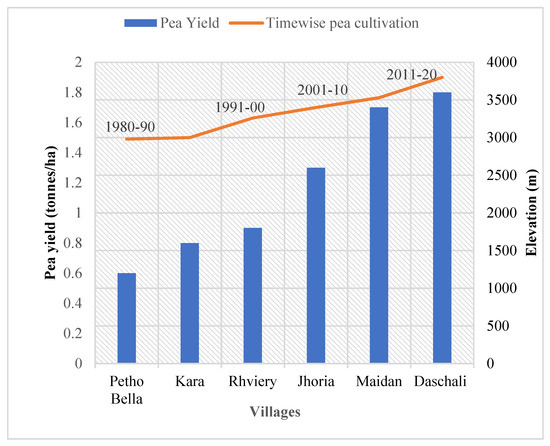
Figure 2.
Time- and elevation-wise pea productivity in Buhrawai valley.
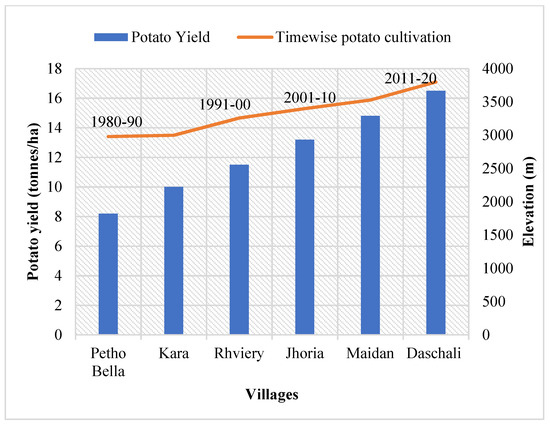
Figure 3.
Time- and elevation-wise potato productivity in Buhrawai valley.
The results further showed that the cultivation of off-season vegetable crops initially started in the low-elevation villages (Petho Bella and Kara), where crop productivity substantially decreased, then farmers slowly expanded cultivation to the higher-elevation villages (Jhoria, Maidan and Daschali). The lack of crop diversification, excessive surface run-off, loss of important soil nutrients from sloping fields, and poor production of humus are key factors contributing to cropland productivity loss in the uplands [16,25]. Due to these factors, old-cultivated land (land cultivated during 1980–2000) in the lower-elevation villages became unproductive or converted to “agricultural abandoned land” (Figure 4), which is dominantly encroached by toxic weeds and invasive shrubs (Figure 5).
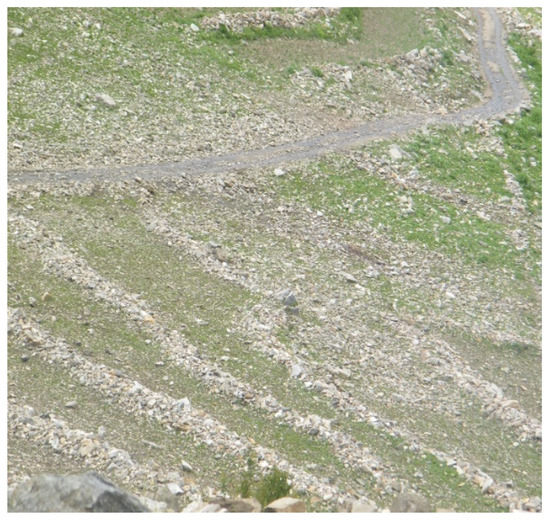
Figure 4.
Agriculture abandoned land in Burhrawai valley.
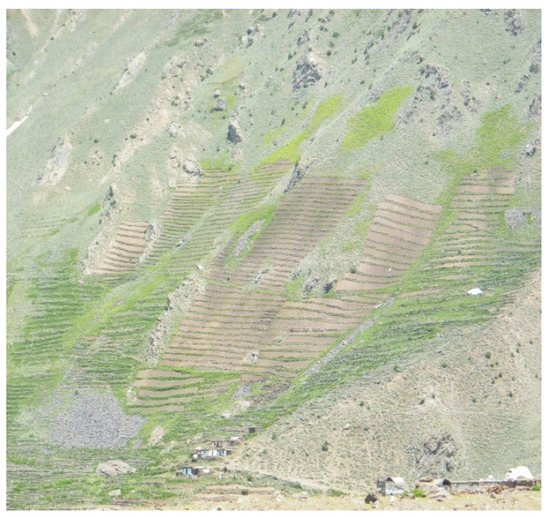
Figure 5.
Weeds and invasive shrubs on agricultural land.
3.3. Crop Encroachment on Hillside Slopes
As a result of cropland productivity loss and overuse of the bottomland, farmers are expanding cultivation to steeper and more fragile hillside slopes, without sustainable land management or other soil conservation measures (Figure 6). However, regular cultivation in mountainous areas is permitted on slopes inferior to 16 degrees, with proper terracing and soil conservation measures [26]. Considering this, in the study area, crop encroachment on hillside slopes is mainly categorized into permissible (≤16°) and non-permissible levels (≥17°). The results showed that cultivation under these slope categories occurred on 279.6 ha (permissible slope) and 137.7 ha (non-permissible slope) of the total cultivated area (Table 3). This cultivation on steep hillside slopes beyond the permissible limit is exacerbating soil erosion, land degradation, and devastating floods [27,28,29]. Subsequently, these environmental hazards are affecting rural livelihoods in Northern Pakistan, and making them more vulnerable to various socio-economic and ecological shocks.
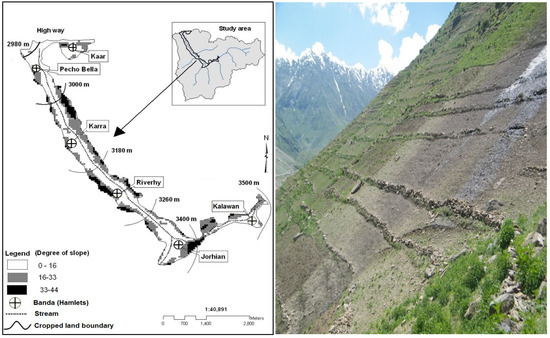
Figure 6.
Cultivation on hillside steep slopes without soil conservation measures.

Table 3.
Crop encroachment toward hillside slopes.
Crop encroachment toward marginal hillside slopes was mainly complemented by the fact that intensive cultivation at the bottomland has deteriorated soil fertility, and increased the demand for agrochemical inputs and hybrid seeds. Consequently, this has reduced the quantity and quality of the produce, and increased the farmers’ dependency on external agrochemical inputs.
3.4. Use Pattern of Agro-Chemical Inputs
We found that the farmers in the study area have been extensively using agrochemical inputs, including fertilizers (diammonium phosphate, nitrophos, and urea) and pesticides (Belldock, Super Kill, Topas, and biotin). The usage of these agrochemicals depends on the land use history, i.e., old and virgin cropland (Table 4), as more agrochemical inputs are required for old-cultivated land to sustain crop productivity, while virgin-cultivated land is relatively more productive, having rich soil nutrients with which a smaller amount of agrochemicals is required [30].

Table 4.
Types of agro-chemical inputs and their use pattern.
The farmers’ interviews revealed that nitrogen fertilizers are applied twice in a season, i.e., before the crop’s planting and at the earthing-up stage of the crop. Further, it was noticed that farmers are largely applying urea as (N) a fertilizer, as this fertilizer is more effective and economically viable for the farmers. However, the usage of this specific fertilizer is not always possible, due to its non-availability in the local markets, where farmers are left with no choice, except to use alternative fertilizers, such as NP, diammonium phosphate, and sulfate of potash (SP). Off-season vegetable crops, such as potatoes and peas, need a sufficient supply of soil nutrients, inorganic fertilizers, and irrigation water [31]. In particular, an excessive supply of inorganic fertilizers requires more monetary inputs, which increase the economic pressure on the farmers’ livelihoods. Furthermore, excessive application of agrochemical inputs in the hillside sloping fields is causing contaminants to leach into water bodies and subsequently deteriorate aquatic ecosystems [32,33,34].
3.5. Socio-Economic and Ecological Scenario
In the uplands of Naran, agro-pastoral societies have shaped a complex socio-ecological system, in which agriculture and transhumance are closely overlapped and influence each other in profound ways (Figure 7). Within this system, off-season agriculture has been adopted by an active and influential mountain society (Syed tribe), while century-old transhumance has been sustained and shaped by landless pastoralists for their livelihood subsistence [8,15].
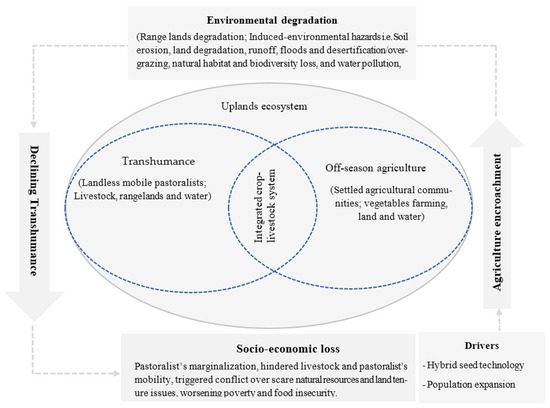
Figure 7.
The framework of socio-ecological systems in the uplands of Naran.
The uplands’ grassland ecosystems provide valuable goods and services, such as forage, foods, timber, freshwater, control of and protection from natural hazards, carbon storage, and recreation and tourism [35,36,37]. These key ecosystem services are widely managed and sustained by pastoralists, whose stewardship toward the environment is being increasingly appreciated and acknowledged in the world [38,39]. However, off-season agriculture encroachment is a key driver of land-use change, and often causes large-scale ecological degradation [40,41] and imposes serious pressure on transhumance or pastoral livelihoods. Some of the perceived ecological and socio-economic impacts of agriculture encroachment were assessed in the study area, and are presented in Figure 7.
The uplands in the Himalayan region of Northern Pakistan are ecologically fragile and economically underdeveloped [25,42]. Cultivation in these uplands usually provides high-cash income opportunities, accommodates surplus labor, and, most importantly, increases the farmers’ hold on the land. However, these opportunities and trade-offs vary within the biophysical and socio-cultural environmental settings. In the study area, off-season agricultural activities have largely destabilized hillside slopes and triggered various environmental hazards, such as increased soil erosion, runoff, land degradation, and devastating floods. Furthermore, this agriculture has significantly reduced the grazing land for landless pastoralists, increased grazing pressure on the remaining pastoral land, and imposed serious restrictions on their livestock mobility and grazing systems. These factors have subsequently exposed landless pastoralists to various socio-economic shocks and vulnerabilities.
3.6. Need for Sustainable Land Management
Extensive multidisciplinary research on the Himalayan mountains has brought general recognition that these upland areas are extremely susceptible to unsustainable development. In the uplands of Northern Pakistan, agriculture encroachment is one of the developmental interventions that has continued on an ad hoc basis, in which the participating communities, particularly tenants, have always focused on their short-term socio-economic benefits, while ignoring the long-term consequences caused by unsustainable agricultural activities in the upland environment. Within this context, sustainable land management (SLM) is an important option that provides multiple opportunities for ecological sustainability, economic efficacy, and social well-being [43]. SLM approaches have not only been adopted to deal with the management of areas under various uses, such as agriculture, pastures, and forests, etc., but also to delineate environmentally critical areas and identify sound restoration measures for degraded land. We recommend the following SLM guidelines, which evolved from the basis of the present study:
- A cross-sectoral and comprehensive land use policy should be devised, particularly for the upland areas (above 2000 m), which delineates the boundaries between cropland, pastures, and forests. This sustainable land use policy will reduce or avoid human-induced pressure on the natural resources of the uplands.
- Within the land use policy, proper guidelines should be provided to avoid cultivation on steeper hillside slopes or beyond the permissible limits. This steep slope cultivation, without proper terracing or other soil conservation measures, is causing large-scale soil erosion and land degradation.
- Unclear land tenure issues should be resolved at the community level, through social dialogues and multi-stakeholder consultation processes. This unclear land tenure system usually triggers land disputes and overuse of the communal land [44].
- Long-term agronomic and biological techniques are required to rehabilitate the degraded landscapes. A considerable proportion of the geographical area has been identified as “agriculture abandoned or overgrazed land”.
- A comprehensive pasture management plan should be devised for sustainable grazing systems in the uplands. Effective management of mountainous areas provides biodiversity conservation, carbon sequestration, and cultural and recreational ecosystem services.
- The landless pastoral system should be valued, and needs to be considered in the land use policy. These landless pastoralists are socio-politically marginalized and the most deprived of their traditional pastoral land.
- Awareness should be raised about key ecosystem services that are shaped and maintained by the described landless pastoralists.
Based on the above-mentioned facts, it is time to adopt environmentally friendly strategies for sustainable mountain development and adjoining plain ecosystems.
4. Conclusions
Mountain agriculture, in the form of off-season vegetable farming, is one of the livelihood activities largely adopted by a locally settled community in the uplands of Naran, in Northern Pakistan. This community has increasingly renounced traditional livestock herding in favor of cash cropping, as it offers high-cash income opportunities and improves social well-being. This study documented the phenomena of off-season crop encroachment over summer pastoral land since its inception in the early 1980s, and further highlighted the socio-economic and ecological consequences caused by this crop’s encroachment in the uplands.
During the past few decades, off-season crop cultivation mainly occurred on traditional pastoral land (summer pastures) in the Buhrawai valley (study area). Initially, this cultivation occupied the bottomlands of the valley, but, later, it was expanded to high-elevation areas and hillside steep slopes. This agricultural encroachment toward marginal hillside slopes is mainly exacerbated by continuous cultivation at the bottomlands, without crop rotation. This has deteriorated soil fertility and increased the demand for agrochemical inputs. Furthermore, the productivity of the virgin-cultivated land is recorded more, in comparison to the old-cultivated land. Consequently, unproductive land at the valley bottom was converted to agriculture abandoned land.
This agricultural expansion on the mountainous steep slopes not only exacerbates the risk of fertility loss, and the need to apply more agrochemical inputs to compensate for the loss, but has also increased the grazing pressure on the remaining available pastures. The cultivation has substantially reduced the available grazing space for the landless pastoralists. As a result, livestock must graze the remaining pastures for a longer duration, without rotation grazing systems. This subsequently leads to overgrazing in high-elevations areas, which are characterized by a shorter growing season and longer grazing duration.
The fragile mountain ecosystems are unsuitable for off-season vegetable cultivation, as it has caused social discrimination, unequal distribution of socio-economic trade-offs among mountain communities, and largely destabilized upland ecosystems in Northern Pakistan.
Author Contributions
Conceptualization, M.K., W.R. and M.N.; methodology, M.K. and M.N.; software, W.U., A.H.L.; validation, M.N. and H.H.; formal analysis, M.K.; investigation, W.R.; resources, H.H.; data curation, W.U.; writing—original draft preparation, M.K. and W.R.; writing—review and editing, M.N. and H.Y.; visualization, W.R.; supervision, M.N.; project administration, M.K. and A.K.; funding acquisition, H.H. and W.U. All authors have read and agreed to the published version of the manuscript.
Funding
This study was conducted within the Start-up Research Grant Program (SRGP) of the Higher Education Commission (HEC), Government of Pakistan (Project No: 2057). We acknowledge the financial support of HEC for this research study.
Institutional Review Board Statement
Because of the observational nature of the study, and in the absence of any involvement of therapeutic medication, no formal approval of the Institutional Review Board of the local Ethics Committee was required. Nonetheless, all subjects were informed about the study and participation was fully on a voluntary basis. Participants were ensured of confidentiality and anonymity of the information associated with the surveys. The study was conducted according to the guidelines of the Declaration of Helsinki.
Informed Consent Statement
Informed consent has been obtained from all subjects involved in this study to publish this paper.
Data Availability Statement
The dataset used in this research is available upon request from the corresponding author. The data are not publicly available due to restrictions, i.e., privacy or ethical.
Conflicts of Interest
The authors declare no conflict of interest. The funders had no role in the design of the study; in the collection, analyses, or interpretation of data; in the writing of the manuscript, or in the decision to publish the results.
References
- Stobdan, T.; Angmo, S.; Angchok, D.; Paljor, E.; Dawa, T.; Tsetan, T.; Chaurasia, O.P. Vegetable Production Scenario in Trans-Himalayan Leh Ladakh Region, India. Def. Life Sci. J. 2018, 3, 85–92. [Google Scholar] [CrossRef]
- Tulachan, P.M. Mountain Agriculture in the Hindu Kush–Himalaya. Mt. Res. Dev. 2001, 21, 260–267. [Google Scholar] [CrossRef]
- Rashid, W.; Rahim, I.; Nafees, M.; Rehman, S.A.U.; Khurshid, M.; Shi, J. Making Goat Herders As Scape Goats For High-Altitude Pasture Degradation: A Case Study Of Haripur-Naran Pastoral System In Northern Pakistan. J. Anim. Plant Sci. 2019, 29, 953–963. [Google Scholar]
- Bhagat, R.M.; Singh, S.; Sood, C.; Rana, R.S.; Kalia, V.; Pradhan, S.; Immerzeel, W.; Shrestha, B. Land Suitability Analysis for Cereal Production in Himachal Pradesh (India) using Geographical Information System. J. Indian Soc. Remote Sens. 2009, 37, 233–240. [Google Scholar] [CrossRef]
- Kreutzmann, H. Accessibility for High Asia: Comparative Perspective on Northern Pakistan’s Traffic Infrastructure and Linkages with Its Neighbours in the Hindukush Karakoram-Himalaya. J. Mt. Sci. 2004, 1, 193–210. [Google Scholar] [CrossRef]
- Bhasin, V. Pastoralists of Himalayas. J. Hum. Ecol. 2011, 33, 147–177. [Google Scholar] [CrossRef]
- Rana, G. The International Centre for Integrated Mountain Development (ICIMOD). Mt. Res. Dev. 2003, 23, 288–289. [Google Scholar] [CrossRef][Green Version]
- Khurshid, M.; Mohammad, N.; Somuncu, M. Understanding the Role of Agriculture Encroachment in Pastoral Resources Degradation in Western Himalaya of Northern Pakistan. Sarhad J. Agric. 2017, 33, 298–305. [Google Scholar] [CrossRef]
- Zinsstag, J.; Bonfoh, B.; Zinsstag, G.; Crump, L.; Alfaroukh, I.O.; Abakar, M.F.; Kasymbekov, J.; Baljinnyam, Z.; Liechti, K.; Seid, M.A.; et al. Une vision de I’avenir du pastoralisme. OIE Rev. Sci. Tech. 2016, 35, 693–716. [Google Scholar] [CrossRef]
- Rueff, H.; Inam-ur-Rahim; Kohler, T.; Mahat, T.J.; Ariza, C. Can the green economy enhance sustainable mountain development? The potential role of awareness building. Environ. Sci. Policy 2015, 49, 85–94. [Google Scholar] [CrossRef]
- Wani, M.-u.-H.; Wani, S.M. Sustainability of Himalayan Environment: Issues and Policies. In Natural Resource Management: Ecological Perspectives. Sustainability in Plant and Crop Protection; Peshin, R., Dhawan, A.K., Eds.; Springer: Cham, Switzerland, 2019; pp. 31–45. [Google Scholar] [CrossRef]
- Angmo, S.; Angmo, P.; Dolkar, D.; Norbu, T.; Paljor, E.; Kumar, B.; Stobdan, T. All Year Round Vegetable Cultivation in Trenches in Cold Arid trans-Himalayan Ladakh. Def. Life Sci. J. 2017, 2, 54–58. [Google Scholar] [CrossRef]
- Rahi, S.; Choudhary, A.K. Integrated crop management practices for off-season cabbage in high-hill wet-temperate region of north-western Himalayas. Ann. Agric. Res. 2016, 37, 406–409. [Google Scholar]
- Tiwari, K.R.; Nyborg, I.L.P.; Sitaula, B.K.; Paudel, G.S. Analysis of the sustainability of upland farming systems in the Middle Mountains region of Nepal. Int. J. Agric. Sustain. 2008, 6, 289–306. [Google Scholar] [CrossRef]
- Rahim, I.U.; Khurshid, M.; Rueff, H.; Nafees, M.; Maselli, D. Crop encroachment over alpine pastures in the himalayan mountains of northern Pakistan: Socio-economic implications for pastoral communities. Range Manag. Agrofor. 2016, 37, 93–97. [Google Scholar]
- MacDonald, D.; Crabtree, J.R.; Wiesinger, G.; Dax, T.; Stamou, N.; Fleury, P.; Lazpita, J.G.; Gibon, A. Agricultural abandonment in mountain areas of Europe: Environmental consequences and policy response. J. Environ. Manag. 2000, 59, 47–69. [Google Scholar] [CrossRef]
- León, N.P.; Bruzzone, O.; Easdale, M.H. A Framework to Tackling the Synchrony between Social and Ecological Phases of the Annual Cyclic Movement of Transhumant Pastoralism. Sustainability 2020, 12, 3462. [Google Scholar] [CrossRef]
- Ullah, W.; Nihei, T.; Nafees, M.; Zaman, R.; Ali, M. Understanding climate change vulnerability, adaptation and risk perceptions at household level in Khyber Pakhtunkhwa, Pakistan. Int. J. Clim. Change Strateg. Manag. 2018, 10, 359–378. [Google Scholar] [CrossRef]
- Qasim, S.; Khan, A.N.; Shrestha, R.P.; Qasim, M. Risk perception of the people in the flood prone Khyber Pukhthunkhwa province of Pakistan. Int. J. Disaster Risk Reduct. 2015, 14, 373–378. [Google Scholar] [CrossRef]
- Bryman, A. Barriers to Integrating Quantitative and Qualitative Research. J. Mix. Methods Res. 2007, 1, 8–22. [Google Scholar] [CrossRef]
- Mugisha, A.; McLeod, A.; Percy, R.; Kyewalabye, E. Socio-economic factors influencing control of vector-borne diseases in the pastoralist system of south western Uganda. Trop. Anim. Health Prod. 2008, 40, 287–297. [Google Scholar] [CrossRef]
- Donohue, C.; Biggs, E. Monitoring socio-environmental change for sustainable development: Developing a Multidimensional Livelihoods Index (MLI). Appl. Geogr. 2015, 62, 391–403. [Google Scholar] [CrossRef]
- Mottet, A.; Ladet, S.; Coque´, N.; Gibon, A. Agricultural land-use change and its drivers in mountain landscapes: A case study in the Pyrenees. Agric. Ecosyst. Environ. 2006, 114, 296–310. [Google Scholar] [CrossRef]
- Rashid, W.; Shi, J.; Rahim, I.U.; Qasim, M.; Baloch, M.N.; Bohnett, E.; Yang, F.; Khan, I.; Ahmad, B. Modelling Potential Distribution of Snow Leopards in Pamir, Northern Pakistan: Implications for Human–Snow Leopard Conflicts. Sustainability 2021, 13, 13229. [Google Scholar] [CrossRef]
- Tiwari, K.R.; Sitaula, B.K.; Bajracharya, R.M.; Børresen, T. Effects of soil and crop management practices on yields, income and nutrients losses from upland farming systems in the Middle Mountains region of Nepal. Nutr. Cycl. Agroecosyst. 2010, 86, 241–253. [Google Scholar] [CrossRef]
- Gupta, R.K. Ecological approach to land capability classification and regional planning. New Dimens. Agric. Geogr. Ecol. Agric. Syst. 1992, 2, 311. [Google Scholar]
- Bakker, M.M.; Govers, G.; Kosmas, C.; Vanacker, V.; Oost, K.V.; Rounsevell, M. Soil erosion as a driver of land-use change. Agric. Ecosyst. Environ. 2005, 105, 467–481. [Google Scholar] [CrossRef]
- Harden, C.P. Soil Erosion and Sustainable Mountain Development. Mt. Res. Dev. 2001, 21, 77–83. [Google Scholar] [CrossRef]
- Sen, K.K.; Rao, K.S.; Saxena, K.G. Soil erosion due to settled upland farming in the Himalaya: A case study in Pranmati watershed. Int. J. Sustain. Dev. World Ecol. 1997, 4, 65–74. [Google Scholar] [CrossRef]
- Chibsa, T.; Ta, A.A. Assessment of Soil Organic Matter under Four Land Use Systems in the Major Soils of Bale Highlands, South East Ethiopia b. Factors Affecting Soil Organic Matter Distribution. World Appl. Sci. J. 2009, 6, 1506–1512. [Google Scholar]
- Nautiyal, S.; Kaechele, H.; Rao, K.S.; Maikhuri, R.K.; Saxena, K.G. Energy and economic analysis of traditional versus introduced crops cultivation in the mountains of the Indian Himalayas: A case study. Energy 2007, 32, 2321–2335. [Google Scholar] [CrossRef]
- Tariq, M.I.; Afzal, S.; Hussain, I.; Sultana, N. Pesticides exposure in Pakistan: A review. Environ. Int. 2007, 33, 1107–1122. [Google Scholar] [CrossRef] [PubMed]
- Quraishi, R.; Akbar, F.; Karim, S.; Neelab; Ahmad, S.; Rashid, W.; Ullah, S. Effects of Pesticides on Haematology, Thyroid Stimulating Hormone (TSH) and Tri-iodothyronine (T3) Hormones of Agricultural Workers in Swat, Pakistan. J. Biol. Life Sci. 2015, 6, 96–107. [Google Scholar] [CrossRef][Green Version]
- Rashid, S.; Shah, I.A.; Tulcan, R.X.S.; Rashid, W.; Sillanpaa, M. Contamination, exposure, and health risk assessment of Hg in Pakistan: A review. Environ. Pollut. 2022, 301, 118995. [Google Scholar] [CrossRef] [PubMed]
- Khurshid, M.; Nafees, M.; Inam-ur-Rahim; Rashid, W. Impacts of Agriculture Land use Changes on Mobile Pastoral System in Naran Valley of Western Himalayan Northern Pakistan. Sarhad J. Agric. 2016, 32, 1–8. [Google Scholar] [CrossRef]
- Sultan, H.; Rashid, W.; Shi, J.; Rahim, I.U.; Nafees, M.; Bohnett, E.; Rashid, S.; Khan, M.T.; Shah, I.A.; Han, H.; et al. Horizon Scan of Transboundary Concerns Impacting Snow Leopard Landscapes in Asia. Land 2022, 11, 248. [Google Scholar] [CrossRef]
- Rashid, W.; Shi, J.; Rahim, I.U.; Dong, S.; Sultan, H. Issues and Opportunities Associated with Trophy Hunting and Tourism in Khunjerab National Park, Northern Pakistan. Animals 2020, 10, 597. [Google Scholar] [CrossRef]
- Koocheki, A.; Gliessman, S.R. Pastoral nomadism, a sustainable system for grazing land management in arid areas. J. Sustain. Agric. 2005, 25, 113–131. [Google Scholar] [CrossRef]
- Nori, S.; Gemini, M. The Common Agricultural Policy vis-à-vis European pastoralists: Principles and practices. Pastor. Res. Policy Pract. 2011, 1, 1–8. [Google Scholar] [CrossRef]
- Gonzalez, P.; Neilson, R.P.; Lenihan, J.M.; Drapek, R.J. Global patterns in the vulnerability of ecosystems to vegetation shifts due to climate change. Glob. Ecol. Biogeogr. 2010, 19, 755–768. [Google Scholar] [CrossRef]
- Löffler, J.; Anschlag, K.; Baker, B.; Finch, O.-D.; Diekkrüger, B.; Wundram, D.; Schröder, B.; Pape, R.; Lundberg, A. Mountain ecosystem response to global change. Erdkunde 2011, 65, 189–213. [Google Scholar] [CrossRef]
- Gupta, A.K.; Negi, M.; Nandy, S.; Alatalo, J.M.; Singh, V.; Pandey, R. Assessing the vulnerability of socio-environmental systems to climate change along an altitude gradient in the Indian Himalayas. Ecol. Indic. 2019, 106, 105512. [Google Scholar] [CrossRef]
- Marques, M.J.; Schwilch, G.; Lauterburg, N.; Crittenden, S.; Tesfai, M.; Stolte, J.; Zdruli, P.; Zucca, C.; Petursdottir, T.; Evelpidou, N.; et al. Multifaceted Impacts of Sustainable Land Management in Drylands: A Review. Sustainability 2016, 8, 177. [Google Scholar] [CrossRef]
- Khurshid, M.; Nafees, M.; Khan, A.; Somuncu, M.; Khan, A.A.; Rashid, W. Socio-political and ecological stresses on traditional pastoral systems: A review. J. Geogr. Sci. 2019, 19, 1758–1770. [Google Scholar] [CrossRef]
Publisher’s Note: MDPI stays neutral with regard to jurisdictional claims in published maps and institutional affiliations. |
© 2022 by the authors. Licensee MDPI, Basel, Switzerland. This article is an open access article distributed under the terms and conditions of the Creative Commons Attribution (CC BY) license (https://creativecommons.org/licenses/by/4.0/).